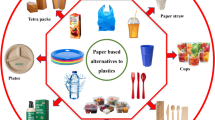Abstract
The aim of this work was to formulate and optimize the washing performance of an alkylpolyglucoside-based dishwashing detergent. The liquid detergent was formulated with five ingredients of commercial origin: anionic (linear sodium alkylbenzenesulfonate and sodium laurylethersulfate), nonionic (C12–C14 alkylpolyglucoside) and zwitterionic (a fatty acid amide derivative with a betaine structure) surfactants, and NaCl for viscosity control. In addition to the plate test, other properties were investigated including “cloud point”, viscosity, and emulsion stability. Statistical analysis software was used to generate a central composite experimental design. Then, a second order design and analysis of experiments approach, known as the Response Surface Methodology, was set up to investigate the effects of the five components of the formulation on the studied properties in the region covering plausible component ranges. The method proved to be efficient for locating the domains of concentrations where the desired properties were met.









Similar content being viewed by others
References
Cahn A (1996) Liquid detergents: an overview. In: Lai KY (ed) Liquid detergents, surfactant science series, vol 67. Marcel Dekker, New York, pp 1–19
Ames GR (1960) Long-chain derivatives of monosaccharides and oligosaccharides. Chem Rev 60:541–553
Egan PA (1989) Surfactants from biomass. Chem Tech, pp 758–762
Andree H, Middelhauve B (1991) Possibilities of the use of alkylpolyglucosides in detergents and cleaning liquids. Tenside Surfactants Deterg 28(6):413–418
Lomax E (1994) Alkylpolyglucosides for personal care, laundry and liquid detergent applications. Speciality Chem Mag 14(1):21–24, 26
Nieendick C, Schmid KH (1995) Alkyl polyglycosides: a new generation of surfactants for the use in manual dishwashing agents. Jornadas Comite Esp Detergencia 26:63–67
Cottrell JS, Rennie GK (1996) Light duty cleaning compositions showing acceptable mildness, cleaning and foaming, WO 9635770
Balzer D (ed) (2000) Nonionic surfactants: alkylpolyglucosides, surfactant science series, vol 91. Marcel Dekker, New York
Soldanski HD, Adomat C, Buisker D (2007) Skin-protecting dishwashing detergents. WO 2007028571
von Rybinski W, Hill K (1998) Alkylpolyglucoside–Eigenschaften und Anwendungen einer neuen Tensidklasse. Angew Chem 110(10):1394–1412
Bognolo G (2004) Tensioactifs non ioniques: mise en oeuvre industrielle. Techniques de l’Ingénieur, Doc J 2(265):1–6, Paris
Balzer D (1991) Alkylpolyglucosides, their physico-chemical properties and their uses. Tenside 28(6):419–427
Nilsson F (1996) Alkylglucosides’ physical-chemical properties. Inform 7(5):490–497
Bognolo G (2004) Tensioactifs non ioniques: propriétés: tableaux comparatifs. Techniques de l’Ingénieur, Comp J 2(266):1–8, Paris
Nickel D, Nitsch C, Kurzendörfer P, von Rybinski W (1992) Interfacial properties of surfactant mixtures with alkylpolyglucosides. Progr Colloid Polym Sci 89:249–252
Hofmann R, Nickel D, von Rybinski W (1994) Grenzflächeneigenschaften und Phasenverhalten von Fettalkoholsulfaten. Tenside Surfactants Deterg 31(1):63–66
Florescu S, Leca M, Rob M, Zahanagiu F, Stanciu I, Filipescu L (1997) Synergistic effects in binary mixtures of alkylpolyglucosides with anionic and nonionic surfactants. Chimica Oggi 15(9/10):43–46
Samdani G, Shanley A (1991) Surfactants: super molecules. Chem Eng (international ed.) 98(3):37, 39, 41, 43
Garcia MT, Ribosa I, Campos E, Sanchez Leal J (1997) Ecological properties of alkylpolyglucosides. Chemosphere 35(3):545–556
Bognolo G (2004) Tensioactifs non ioniques: mise en oeuvre industrielle, Techniques de l’Ingénieur J 2(265):1–9, Paris
ISO 4198 (1984) Surface active agents––detergents for hand dishwashing––guide for comparative testing of performance, international organization for standardization, http://www.iso.ch/iso
Ahmed Zaïd T, Bensari L, Benmaza K, Chitour CE, Canselier JP, Pierlot C (2007) Response surface methodology as an approach to the optimization of a dishwashing detergent. Tenside Surfactants Deterg 44(2):94–101
ASTM D4009-92 (2006) Standard guide for foam stability of hand dishwashing detergents
Simion FA, Warscjewski DW, Zyzyck LA (1990) U.S. Patent 4,923,635 to Colgate-Palmolive Co
Statistica software, kernel version 5.5, StatSoft Inc., http://www.statsoft.com (1984–2006)
Drozd JC, Gorman W (1988) Formulating characteristics of high and low 2-phenyl linear alkylbenzene sulfonates in liquid detergents. J Am Oil Chem Soc 65:398
Acknowledgments
The authors wish to thank Henkel-Cognis (Algeria) for supplying all the components used in this study.
Author information
Authors and Affiliations
Corresponding author
About this article
Cite this article
Bozetine, I., Ahmed Zaïd, T., Chitour, C.E. et al. Optimization of an Alkylpolyglucoside-Based Dishwashing Detergent Formulation. J Surfact Deterg 11, 299–305 (2008). https://doi.org/10.1007/s11743-008-1089-z
Received:
Accepted:
Published:
Issue Date:
DOI: https://doi.org/10.1007/s11743-008-1089-z




